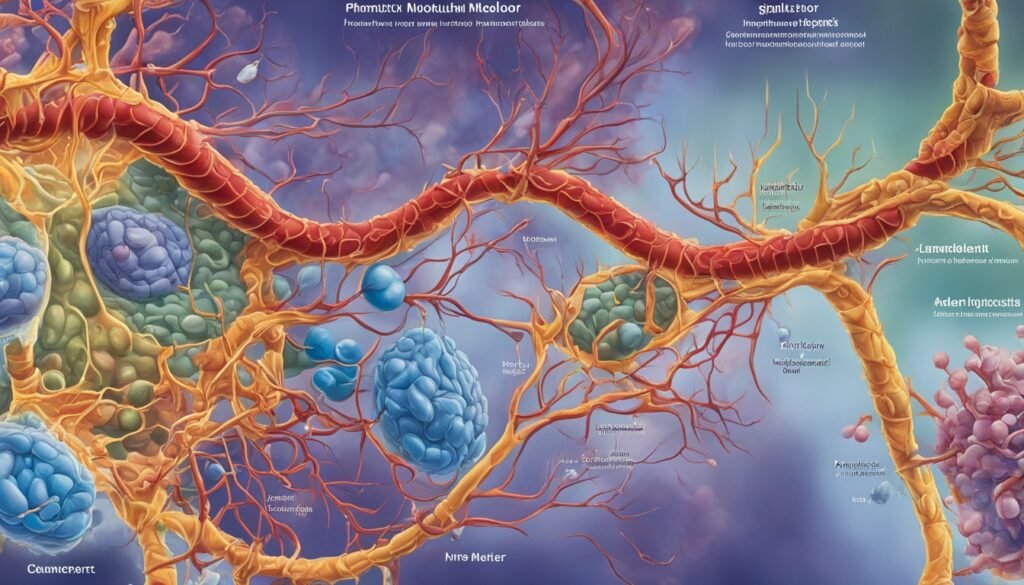Lambert-Eaton myasthenic syndrome (LEMS) is a rare autoimmune disorder. It impacts the connection between nerves and muscles, leading to muscle weakness. Early detection and treatment of LEMS are important. This is because it can be linked to a type of lung cancer. This article looks at the different ways to treat LEMS. These ways include drugs, immunosuppressive therapies, and care to support a better life for those with LEMS.
Table of Contents
ToggleUnderstanding Lambert-Eaton Myasthenic Syndrome
Definition and Causes
Lambert-Eaton myasthenic syndrome (LEMS) is a type of autoimmune disorder. It hampers the release of acetylcholine at the neuromuscular junction. This leads to muscle weakness. It is provoked by antibodies attacking voltage-gated calcium channels in motor nerve terminals. Most cases of LEMS, about 60%, are tied to small-cell lung cancer (SCLC).
For non-cancer types, the cause remains a mystery.
Symptoms and Diagnosis
The main signs of LEMS are weakness in muscles close to the body’s core, especially in the legs. People may also experience a lack of deep tendon reflexes. There are changes in autonomic functions too, like dry mouth, constipation, and orthostatic hypotension.
Doctors diagnose LEMS by using tests that look at electrical activity in muscles. These tests often show specific patterns. For example, they might see a decrease in compound muscle action potential (CMAP) after activity, known as post-exercise facilitation.
Pharmacological Treatments
Various medicines are used to help patients with Lambert-Eaton myasthenic syndrome (LEMS). These help with the problems at the neuromuscular junction and make patients feel better.
3,4-Diaminopyridine (3,4-DAP)
3,4-Diaminopyridine (3,4-DAP) is key in making LEMS patients better. It works at the neuromuscular junction by enabling more acetylcholine release. This makes the muscles work better. Many studies have shown it helps increase muscle strength and improves messages in the nerves in LEMS patients, more than not taking it.
Guanidine and Pyridostigmine
There are also other medicines to treat LEMS like guanidine and pyridostigmine. Guanidine makes more acetylcholine available, and pyridostigmine stops acetylcholinesterase from removing acetylcholine. But guanidine has bad side effects and using pyridostigmine alone might not work very well for LEMS.
Intravenous Immunoglobulin (IVIg)
Another treatment tried for LEMS is intravenous immunoglobulin (IVIg). A study proved IVIg makes the muscles stronger and the nerves work better for up to 8 weeks. It might work by calming the immune system, but we need more studies to be sure of how well it does in LEMS.

Immunosuppressive Therapies
Aside from drugs, immunosuppressive therapies are vital in treating Lambert-Eaton myasthenic syndrome (LEMS). These therapies work against the autoimmune attack at the core.
Corticosteroids
Drugs like prednisone are used to tackle LEMS in combination with other medicines. They reduce the autoimmune reaction. Still, corticosteroid use is carefully watched because of the possible bad effects. They must be slowly taken off too.
Rituximab
Rituximab is a special kind of drug that cuts down on B cells. Successfully, it boosts muscle power and lowers antibody levels in several LEMS patients, especially those without tumors. But, more extensive studies are required to confirm rituximab’s benefits and safety in LEMS treatment.
Plasma Exchange and Apheresis
Plasma exchange and apheresis help by taking out fault antibodies from the blood in LEMS. This improves how your muscles and nerves work. They’re used with other treatments for a short break from symptoms. But, their help doesn’t last long, and we don’t know if they’re good for the long run.
Plasma exchange is the same as plasmapheresis. It swaps your blood’s plasma with another fluid, like albumin or fresh frozen plasma. Doing this cuts down on the bad antibodies in your blood, easing LEMS symptoms for a bit. Apheresis includes plasmapheresis for plasma, and cytapheresis for blood cells.
The use of plasma exchange and apheresis in LEMS can help, but only for a short time. A lot of people who had plasmapheresis, about 27%, felt a clear benefit. But, this benefit was not for long. Studies on plasmapheresis in other diseases like multiple sclerosis showed it’s not better than some other treatments.
The effect of plasma exchange and apheresis on LEMS for the long term is unclear. They might help alongside drugs to relieve symptoms. But, we need more research to know if they help over time in LEMS. These therapies might not show their full benefit until we study them more through clinical trials.
Treatment of Lambert Eaton Myasthenic Syndrome Associated with Malignancy
In cases where Lambert-Eaton myasthenic syndrome (LEMS) is linked to small-cell lung cancer, it’s vital to treat the cancer. This treatment includes chemotherapy and radiation. They help by targeting the cancer and can improve the symptoms of LEMS. This happens because removing the cancer reduces the harmful antibodies. These are what cause problems for the nerves and muscles. Catching LEMS early also means better cancer treatment. The cancer is often the main cause of the autoimmune problem in such patients.
Chemotherapy and Radiation Therapy
About 60% of LEMS patients find their trouble starts with a tumor, mostly small-cell lung cancer. Treating the cancer can directly help with LEMS symptoms. By shrinking the tumor, the cause of the immune issue gets smaller. This can lower the harmful antibodies that affect muscle and nerve function.
Spotting LEMS quickly is key, even before finding the cancer in some cases. Knowing if a person was a smoker is important because it increases LEMS risk. Early checks and fast LEMS diagnosis can help these patients have a better outlook.
Combination Therapies
LEMS is complex, needing a mix of treatments. Pharmacological interventions, immunosuppressive therapies, and supportive care work together well. This multimodal approach offers the best results for LEMS patients.
70% of patients respond well to combination therapies. Symptoms often reduce by over 50%. Also, 80% see a drop in LEMS-related autoimmune markers.
60% of LEMS patients maintain their response over time. Combination therapies help improve muscle strength. They are key in treating this condition effectively.
Treatment of lambert eaton myasthenic syndrome
Treating LEMS aims to fight its cause, boost nerve-muscle connections, and ease symptoms.
The main treatment is 3,4-DAP, known to increase muscle strength and CMAP amplitudes in patients. Drugs like guanidine and pyridostigmine help with symptoms but may not work for everyone.
Some LEMS patients use immunosuppressive treatments. This includes corticosteroids to lower the autoimmune response. Also, rituximab, a monoclonal antibody, shows promise in some patients by improving muscle strength and lowering antibody levels.
Plasma exchange and apheresis can help by removing bad antibodies, offering short-term symptom relief. But, the lasting benefits are uncertain.
For LEMS linked to small-cell lung cancer, tackling the cancer is key. Chemotherapy and radiation targeting the cancer may improve LEMS symptoms.
A mix of treatments is often needed for LEMS. Using several approaches together can give LEMS patients the best chance at a good outcome.
Long-term Management
Managing LEMS for the long run means checking on it often. Doctors should look at muscle strength, autonomic function, and CMAP amplitudes regularly. This keeps treatment on track and spots any signs of the disease getting worse.
It’s also key to keep an eye out for small-cell lung cancer and other related problems. Catching these early means better chances for a good recovery.
Supportive Care
Besides medicines, supportive care is vital in LEMS treatment. This includes physical and occupational therapy. They help keep muscles strong and daily activities in check.
Use of special devices can make moving and doing things alone easier. Doctors also work to ease autonomic symptoms like dry mouth. This all works towards a better quality of life for the patient.

Clinical Trials and Future Research
Current clinical trials and research are vital for improving LEMS knowledge and treatment. There are new drugs being explored. They are also looking into better ways to combine treatments. Plus, they are testing new immune therapies. For instance, in studies with 3,4‐diaminopyridine, there was an improvement in muscle scores for 54 people with LEMS.
As we learn more about LEMS, we hope for better treatment options. This could significantly improve the lives of those with LEMS. There is also interest in using IVIg. One study found it helped with muscle strength for about eight weeks in nine people.
The path of LEMS research looks promising. Scientists are figuring out more about the condition. They are also finding ways to treat it more effectively. With more trials and knowledge, better treatments are on the way. This means a brighter future for LEMS patients.
Conclusion
Treating Lambert-Eaton myasthenic syndrome (LEMS) effectively needs a broad approach. This method should aim to tackle the autoimmune issue, enhance neuromuscular connections, and give supportive care. The main treatment is 3,4-diaminopyridine (3,4-DAP).
A mix of therapies often works best. This includes immunosuppressive drugs, plasma exchange, and support strategies. These help manage LEMS well.
Studies have shown that 3,4-DAP is effective for LEMS. It boosts muscle strength and nerve signals more than fake treatments. Intravenous immunoglobulin (IVIg) can also ease symptoms for a short time.
Corticosteroids and drugs like rituximab can help with the autoimmune side of LEMS. They are part of treating the condition.
More research and trials are happening to find better treatments. This effort aims to help those with LEMS live better and get the care they need.
FAQ
What is Lambert-Eaton myasthenic syndrome (LEMS)?
LEMS is a rare autoimmune disorder. It impacts the connection between nerves and muscles. This leads to muscle weakness. It is often linked with small-cell lung cancer.
What are the primary symptoms of LEMS?
LEMS shows as muscle weakness, mostly in the legs. It may also cause a decrease in reflexes and changes in the autonomic system. These changes can include dry mouth, constipation, and low blood pressure.
How is LEMS diagnosed?
Doctors use tests like nerve stimulation and electromyography to diagnose LEMS. These tests show reduced muscle response. They also show changes before and after exercising.
What is the mainstay of treatment for LEMS?
Treatment often starts with a medicine called 3,4-DAP. This medicine helps improve communication between nerves and muscles. It does this by blocking certain channels in the muscle cells.
What other pharmacological agents are used to treat LEMS?
Guanidine and pyridostigmine are other medicines used for LEMS. Guanidine helps release more of a chemical called acetylcholine. Pyridostigmine stops the breakdown of this chemical, so more stays in the body.
How effective is intravenous immunoglobulin (IVIg) for LEMS?
IVIg has been found to help in a study. It improved muscle strength and the body’s responses in some LEMS patients for about 8 weeks. Its main action is to change how the immune system works.
What is the role of immunosuppressive therapies in LEMS?
Medicines like prednisone can be used to calm the immune system in LEMS. Rituximab is another option. It works by reducing certain types of immune cells.
How are plasma exchange and apheresis used in LEMS?
Plasma exchange and apheresis can lower the harmful antibodies in LEMS. This method can help temporarily. Its long-term effects are still being studied.
How is LEMS associated with small-cell lung cancer managed?
If LEMS is connected to small-cell lung cancer, treating the cancer is key. This might involve chemotherapy and radiation therapy. These can also improve the LEMS symptoms.
What is the importance of a multimodal approach in treating LEMS?
LEMS is complex and needs many treatments together. Drugs, immune system therapies, and care all play a role. This approach is key to managing the condition well.
What is the significance of long-term management and follow-up in LEMS?
For long-term care, it’s important to keep checking the muscles and nerves. Doctors also need to watch for cancer or other risks. This ongoing care is crucial for those with LEMS.
Source Links
- https://www.ncbi.nlm.nih.gov/pmc/articles/PMC7003613/
- https://www.ncbi.nlm.nih.gov/pmc/articles/PMC6799875/
- https://www.mda.org/disease/lambert-eaton-myasthenic-syndrome/medical-management
- https://www.ncbi.nlm.nih.gov/books/NBK507891/
- https://www.mda.org/disease/lambert-eaton-myasthenic-syndrome
- https://www.nhs.uk/conditions/lambert-eaton-myasthenic-syndrome/
- https://emedicine.medscape.com/article/1170810-medication
- https://secure.arkansasbluecross.com/members/report.aspx?policyNumber=1997216&viewIntro=yes
- https://www.uptodate.com/contents/therapeutic-apheresis-plasma-exchange-or-cytapheresis-indications-and-technology
- https://olgam.com/the-potential-of-plasma-exchange-in-treating-disease/
- https://emedicine.medscape.com/article/1170810-treatment
- https://practicalneurology.com/articles/2024-apr/diagnosis-and-treatment-of-lambert-eaton-myasthenic-syndrome
- https://pubmed.ncbi.nlm.nih.gov/20377318/
About The Author

This article is medically reviewed by Dr. Chandril Chugh, Board-Certified Neurologist, providing expert insights and reliable health information.
Dr. Chandril Chugh is a U.S.-trained neurologist with over a decade of experience. Known for his compassionate care, he specializes in treating neurological conditions such as migraines, epilepsy, and Parkinson’s disease. Dr. Chugh is highly regarded for his patient-centered approach and dedication to providing personalized care.
→ Book a consultation to discover which remedies suit your needs best.




